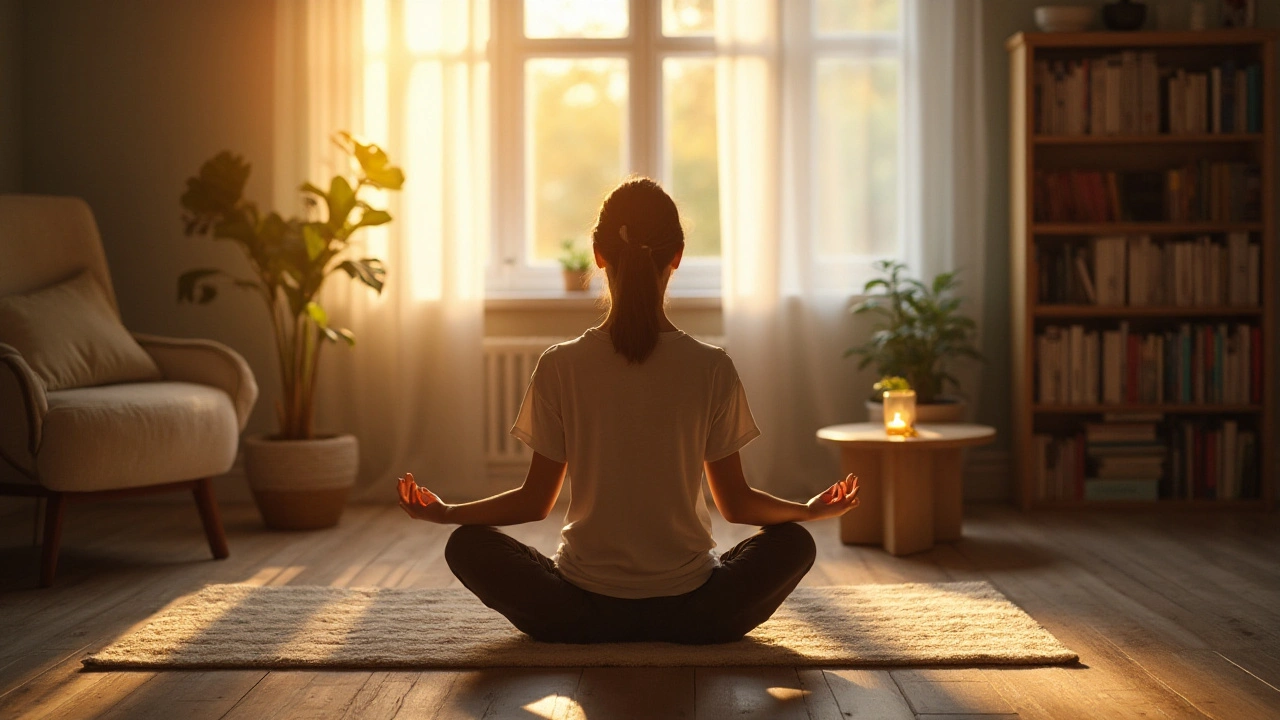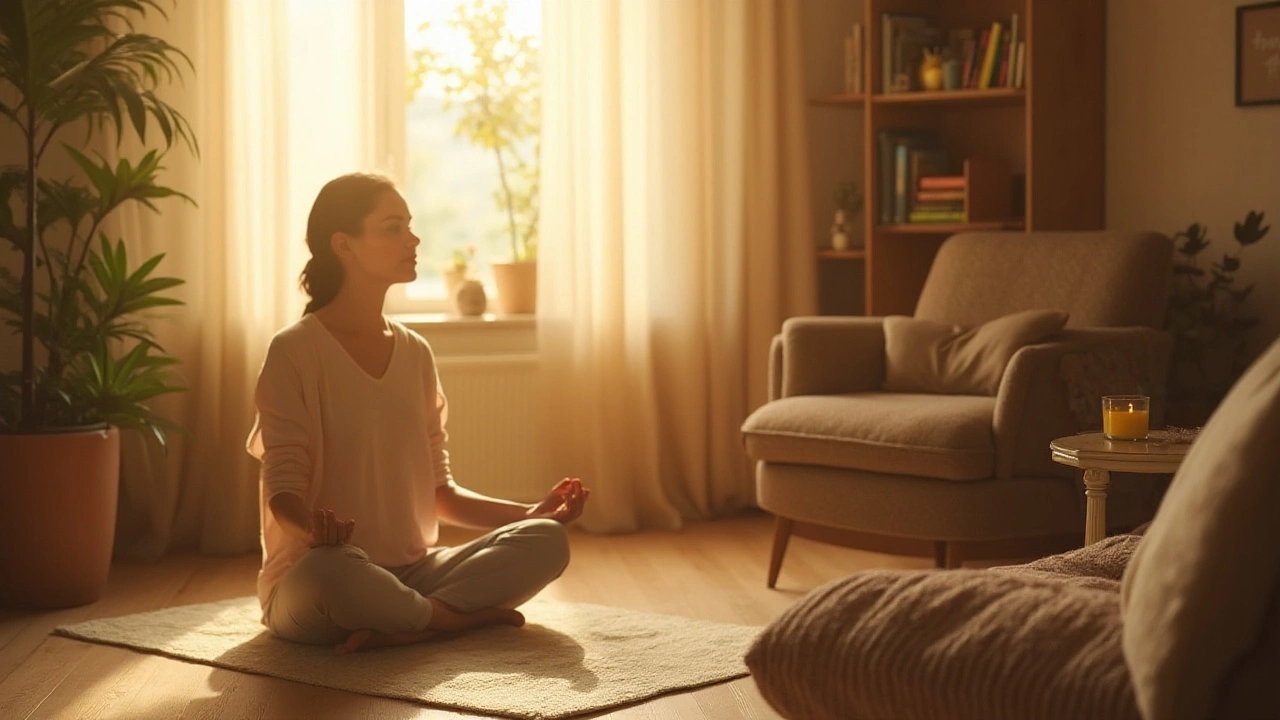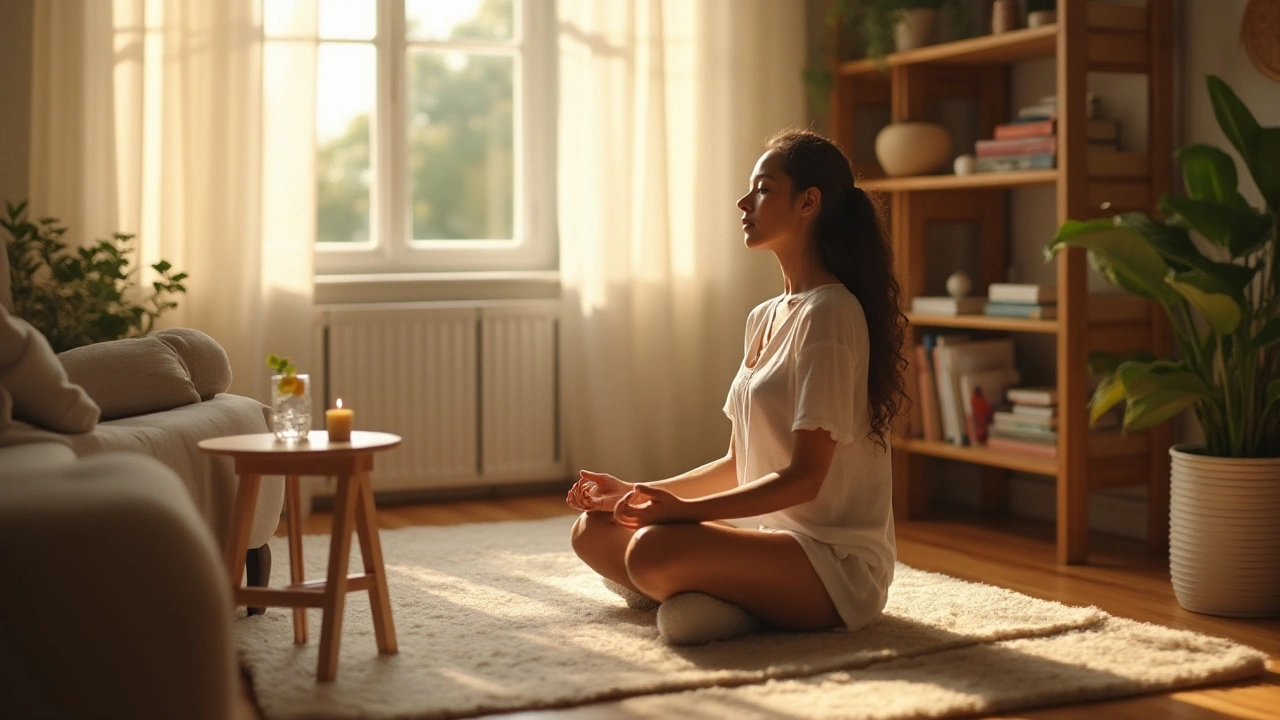Life these days can feel like a whirlwind. Stressors come in all shapes and sizes, from work deadlines to personal responsibilities. The trick is not just managing stress but mastering the art of relaxation.
This article dives into effective ways to bring calm into your life. Whether it's through something simple like a breathing exercise or a mindful practice, these techniques can make a world of difference.
Incorporating these methods into your daily routine could be the key to long-term mental wellness. Let’s explore how you can reclaim your peace of mind, one step at a time.
- The Importance of Relaxation
- Breathing Exercises
- Mindfulness Practices
- Physical Activities
- Relaxation through Hobbies
- Creating a Relaxing Environment
The Importance of Relaxation
In our fast-paced world, finding time to relax might seem like a luxury, but it's a crucial aspect of maintaining your mental and physical health. The never-ending demands from work, family, and social obligations can leave you feeling drained and overwhelmed. This stress, while sometimes manageable in the short term, can have significant long-term impacts if not addressed properly. According to the American Psychological Association, chronic stress can contribute to or exacerbate a variety of physical and mental health issues, including heart disease, diabetes, anxiety, depression, and more.
Relaxation techniques are essential tools in our toolkit to combat these stressors. They help to lower the levels of cortisol, the stress hormone, in our bodies. When cortisol levels are consistently high, it can lead to numerous health problems. Effective relaxation methods can mitigate these effects by inducing the body's relaxation response, lowering blood pressure, slowing the heart rate, and boosting mood. A study from Harvard Medical School found that practices like deep breathing and meditation help improve these aspects significantly.
"The relaxation response is a physical state of deep rest that changes the physical and emotional responses to stress... and the opposite of the fight or flight response," says Dr. Herbert Benson, a pioneer in mind-body medicine.
Beyond the physical benefits, taking time to unwind has a profound effect on mental clarity and emotional stability. Regular relaxation practices are linked to improved cognitive function, increased concentration, and enhanced creativity. When your mind isn't bogged down by stress, it has more space to process information efficiently and think more clearly. This is why many successful individuals incorporate relaxation into their routines, giving them a mental edge in their professional and personal lives.
Moreover, relaxation isn't just about feeling good in the moment; it has enduring benefits. People who practice relaxation techniques regularly often report a deeper sense of well-being and life satisfaction. They find it easier to cope with life's ups and downs, maintain positive relationships, and experience a greater overall sense of happiness. In contrast, those who neglect relaxation may find themselves constantly on edge, less productive, and more prone to burnout.
It's important to remember that relaxation doesn't require huge blocks of time or a special setting. Simple activities like taking a walk, listening to calming music, or enjoying a hobby can be incredibly effective. The key is consistency. By incorporating small, regular moments of relaxation into your day, you can reap the substantial benefits without needing to make drastic changes to your schedule.
Next time you feel that tightness in your chest or notice your thoughts racing, consider taking a few minutes to practice a relaxation technique. Your body and mind will thank you. With regular practice, you’ll not only manage stress better but also lead a healthier, more balanced life.
Breathing Exercises
Breathing exercises are often overlooked, but they are one of the simplest and most effective ways to reduce stress. When you focus on your breath, you can bring about a sense of calm quickly. One popular technique is deep, diaphragmatic breathing. This involves breathing deeply into your belly rather than shallowly into your chest. Try this: place one hand on your chest and the other on your belly. Take a deep breath in through your nose, letting your belly push your hand out. Your chest should not move. Exhale through pursed lips like you are whistling. Do this 5-10 times, and you may feel a significant reduction in stress.
“Deep breathing sends a message to your brain to calm down and relax,” says the American Institute of Stress.
Another method is the 4-7-8 breathing technique. Created by Dr. Andrew Weil, this exercise can help ease your mind at the end of a long day. Here’s how it works: breathe in silently through your nose for a count of four, hold your breath for a count of seven, and exhale completely through your mouth, making a whoosh sound to a count of eight. Repeat this cycle three more times for a total of four breaths. It's designed to follow a natural rhythm that can help you relax fast. Regular practice can also improve your sleep.
Square breathing, or box breathing, is favored by many, including Navy SEALs. This technique is perfect if you need immediate relief. To perform box breathing, you need to picture a square. Breathe in for a count of four, hold your breath for a count of four, breathe out for a count of four, and finally, hold your breath again for a count of four. This cycle can be repeated several times until you notice your anxiety levels decrease. It’s the structured rhythm of this technique that helps bring about a state of calm.
Benefits of Breathing Exercises
There are numerous benefits to practicing breathing exercises regularly. First and foremost, it helps improve your lung capability and oxygen flow. This increased oxygen intake can promote mental clarity and focus. Other advantages include the reduction of blood pressure and an increase in energy levels. It can also lower the level of stress hormones in your blood, thus helping you maintain a more balanced mood. Breathing exercises can become a powerful tool in your relaxation toolkit.
In addition to physical benefits, these exercises also positively impact your mental state. Regular practice can lead to improved mindfulness and emotional stability. While the techniques require time to perfect, the benefits make it worth the effort. Start incorporating these breathing exercises into your daily routine for a calmer, more centered life.

Mindfulness Practices
Mindfulness is all about being present. It involves focusing on the moment, really paying attention to your thoughts, feelings, and sensations. When you're fully engaged in the present, it can be easier to let go of worries about the past or future.
One of the most well-known exercises is mindful breathing. To practice this, find a quiet place to sit or lie down. Close your eyes and take a deep breath in, then slowly let it out. Pay close attention to the sensation of the air filling your lungs and then leaving your body. This simple activity can make a big difference in stress levels.
Another popular approach is body scan meditation. Start at the top of your head and work your way down to your toes. As you mentally scan each part of your body, notice any areas of tension or discomfort. Imagine breathing into those areas to release the tension. Body scan meditation helps to connect mind and body, promoting a feeling of relaxation.
Incorporating mindfulness into daily activities is also effective. Washing dishes, walking, or even eating can be a mindful practice. Focus on the activity at hand, the texture of the dish, the sound of your footsteps, or the taste of your food. Engaging fully in these activities shifts your attention away from stress.
"Mindfulness means paying attention in a particular way; on purpose, in the present moment, and non-judgmentally." - Jon Kabat-Zinn
Studies have shown that regular mindfulness practice can lead to better mental health. According to a study published in the journal JAMA Internal Medicine, mindfulness meditation programs can result in “moderate” improvement in anxiety, depression, and pain.
For anyone looking to get started, guided meditations can be especially useful. Apps like Headspace and Calm offer a wide variety of sessions, ensuring that beginners have the support they need.
Mindfulness isn't just for adults. Schools and parents are recognizing its benefit for children, too. Teaching kids to be mindful can help them manage stress and build emotional resilience.
If you’re new to mindfulness, it might take some time to find what works best for you. The key is consistency. Even just a few minutes a day can make a big difference. Start small, and gradually build up the time you spend practicing.
Physical Activities
Engaging in physical activities is a fantastic way to manage and reduce stress. Not only do these activities help keep the body healthy, but they also promote mental wellness. Exercise releases endorphins, the body's natural mood lifters, which contribute to feelings of happiness and relief from anxiety. Studies show that just 30 minutes of regular physical activity can significantly reduce stress levels and improve mood.
One of the simplest forms of physical activity is walking. A brisk walk in the park or around your neighborhood can work wonders for your mental state. It's also an excellent opportunity to be amidst nature, which itself is a powerful stress-buster. A recent study from Stanford University emphasizes that spending time in nature can lead to lower levels of stress hormones.
For those who enjoy a more vigorous workout, activities like running, swimming, or cycling can be very effective. These exercises elevate your heart rate and trigger the release of stress-relieving endorphins. For many, the rhythm of running or pedaling can be meditative, helping to clear the mind and focus thoughts. As the famous saying goes, "Running is therapy."
"Physical activity is one of the most effective ways to reduce stress. It pumps up your endorphins, making you feel good naturally." - Mayo Clinic
Group activities like yoga and Pilates are also excellent options. These exercises combine physical movement with mindful breathing, offering a dual benefit. Many people find the community aspect of group exercises encouraging and motivating. Yoga, in particular, has been shown to reduce the levels of cortisol, a primary stress hormone. A study published in the Journal of Alternative and Complementary Medicine found that yoga practitioners experienced significant stress reduction after just a few weeks.
Don’t overlook the benefits of dancing. It’s a joyful way to stay active, and it can be done alone or in a group. Dancing to your favorite tunes can instantly lift your spirits. It combines aerobic and anaerobic movements, which means it’s great for your cardiovascular health. Beyond the physical perks, dancing also allows you to express yourself creatively, which can be incredibly liberating.
If you prefer something more structured, consider joining a local sports team. Engaging in team sports like soccer or basketball provides physical exercise and social interaction, both of which are beneficial for mental health. The camaraderie and teamwork involved serve as an antidote to stress. It’s also a fun way to be active without feeling like you’re “exercising.”
Even when time is limited, short physical activities can still offer great benefits. Simple stretches at your desk or a few minutes of jumping jacks can help break the cycle of a stressful day. Incorporating these mini-exercises into your routine can lead to better stress management over time.

Relaxation through Hobbies
Hobbies are more than just pastimes. They offer a wonderful way to relieve stress and bring a sense of joy and accomplishment. Engaging in activities you love can be a powerful method for achieving relaxation. Whether it’s painting, gardening, or playing an instrument, these pursuits allow us to shift focus away from daily worries and fully dive into something positive and enjoyable.
Many people experience a state of 'flow' when they are immersed in their hobbies. This state, defined by psychologist Mihaly Csikszentmihalyi, is a deeply satisfying experience in which time seems to disappear and you lose yourself in the activity. According to Csikszentmihalyi, engaging in activities that allow us to enter this state can significantly boost happiness and reduce stress.
Mihaly Csikszentmihalyi once said, 'The best moments in our lives are not the passive, receptive, relaxing times ... The best moments usually occur when a person's body or mind is stretched to its limits in a voluntary effort to accomplish something difficult and worthwhile.'
Not all hobbies need to be complex or skill-intensive. Simple activities like knitting, coloring, or assembling puzzles can also provide a wonderful escape from stress. These activities require just enough concentration to take your mind off problems, yet don’t demand too much effort or expertise. Consider setting aside a dedicated time each week for your hobby. Make it a ritual and treat it like an essential appointment you can’t miss.
A study published in the ‘Journal of Occupational and Organizational Psychology’ found that people who regularly engaged in creative hobbies outside work reported higher levels of job performance and lower levels of burnout. This is because hobbies offer a perfect outlet to relax and recharge, allowing you to return to your daily responsibilities with renewed energy and a clear mind.
Mental wellness isn't the only benefit. Hobbies often bring social connections, too. Whether you join a club, take a class, or find an online community, shared interests can foster interaction and build friendships. These social components provide additional layers of support and relaxation, further reducing stress and enhancing life satisfaction. Consider a hobby that might include others, like a book club or a cooking group, to combine the benefits of socializing with the joy of your activity.
Another advantage of hobbies is the physical relaxation they offer. Activities like yoga, gardening, or dancing get you moving, which can help relax your muscles and release built-up tension. Physical movement, combined with mental engagement, creates a holistic approach to relaxation that benefits both mind and body.
Finding the right hobby can take some trial and error. Don’t be afraid to try different activities until you find something that truly resonates with you. And remember, the main purpose is to create a space where you can relax and feel joyful. So, choose activities based on what makes you happy, not on what seems popular or traditional.
Creating a Relaxing Environment
One of the most effective ways to manage stress is by designing a physical space that promotes relaxation. Your environment plays a significant role in influencing your mental state. Simple changes in your home or workspace can create an atmosphere of calm and tranquility.
Start by decluttering. A cluttered space can contribute to a cluttered mind. Remove unnecessary items and find a home for everything else. It might sound like a small step, but you'll be amazed at how a tidy area can lift your mood.
Consider the colors you use in your surroundings. Soft, earthy tones like blues, greens, and purples are known to have calming effects, whereas bright, bold hues might make you feel more energized or agitated. You don't need to repaint your entire house; small touches like cushions, throws, or wall art can make a significant difference.
Lighting is another crucial factor. Natural light is ideal, so let in as much as possible. For artificial lighting, opt for softer, warmer lights rather than harsh, bright ones. Candles can also add a soothing touch. Scented candles with lavender or chamomile can be particularly relaxing.
Plants can bring a breath of fresh air to your space — literally! Studies have shown that indoor plants can reduce stress, improve air quality, and boost your mood. Consider adding low-maintenance plants like succulents, snake plants, or even a small herb garden.
Incorporating sounds can be incredibly effective. Playing soft, soothing music or nature sounds can instantly make a space feel more relaxed. You might also consider a white noise machine if you find that background sounds help calm your mind.
Remember to create a specific spot where you can unwind. Whether it's a cozy chair, a yoga mat, or a hammock, having a designated relaxation area can signal to your brain that it's time to relax.
Lastly, think about scents. Essential oils like lavender, eucalyptus, and peppermint can be diffused to create a calming atmosphere. Even something as simple as brewing a cup of herbal tea can fill your space with a soothing scent.
"Your home should be a retreat from the outside world, a place where you can recover your peace." - Marie Kondo
By focusing on these elements, you'll find that creating a relaxing environment is easier than you thought. Not only will your space look great, but your mind will feel calmer too. It's all about making small, deliberate changes that lead to a more peaceful atmosphere.






